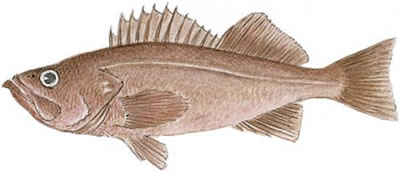Bocaccio
Abundant off the central and the southern coasts of California, the bocaccio is one of the most commercially important rockfish in that region. It is also a well-known gamefish in its range and a good eating fish, with soft and juicy white meat.
Identification
Although its elongate and compressed body form is less bulky than that of most fish in the scorpionfish family, the bocaccio has a large mouth. The upper jaw extends farther back than the eyes; the lower jaw extends past the upper one considerably. The first dorsal fin has spines and is deeply notched, and there are usually nine soft rays in the anal fin.Bocaccio are variably colored olive or brown on the back, reddish on the sides, and pink or white on the bellies. Young fish are generally light bronze, with speckling over the sides and the backs. As they mature, their color generally becomes darker and the speckling gradually disappears.
 |  |
Size/Age
Bocaccio can grow up to 3 feet and 21 pounds and can live for 30 years.Life history/Behavior
Bocaccio that are 1 or 2 years old travel in loose schools and move into shallow water, where they may be captured in quantity. With increasing age, they seek deeper water and move from near the surface to near the bottom. Adults are commonly found in waters of 250 to 750 feet over a somewhat irregular, hard, or rubble bottom. They are known to dwell in depths as great as 1,050 feet.Females start maturing when they are 17 inches long. As with all rockfish, fertilization is internal, and development of the embryos takes place within the ovaries of the female until the eggs are ready to hatch.

0 Response to "Bocaccio"
Post a Comment